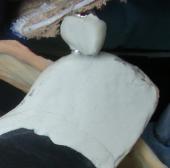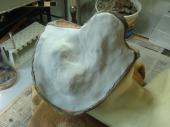Materials: Epoxy Putty

Epoxy putties are two-part compounds which, once mixed, will permanently cure at room temperature into a tough, rigid, plastic-y material. There are many varieties of epoxy putties, making it extremely versatile stuff!
Most epoxy putties require you to mix an equal amount of their two parts. The two parts are often different colors, making it easier to tell when they are thoroughly mixed. For best results, knead both materials together for at least two full minutes (unless the directions say otherwise). Don't try to rush it - unmixed material will fail to cure and remain sticky.
Each type of putty will have different properties. Read the directions on the putty you're using to find out its working time (how long it will remain soft enough to use) and its cure time (how long until it is completely hardened).
General Tips:
- Curing is a chemical reaction. Once both parts have been mixed, they are going to cure no matter what. You cannot reuse extra material, so try not to mix more material than you need.
- Wear disposable gloves. Make sure to read the directions on the putty you're using, because some types might react poorly to latex and require latex-free gloves.
- Be careful not to get any of Part A in Part B's container, and vice versa! You will end up with little shards or skins of cured material that will make the rest of it more difficult to work with.
Types of Epoxy Putties
As I mentioned, epoxy putties come in many types, from adhesives and plumbing repair putties found in hardware stores, to specialized artistic sculpting materials. I'll describe the ones I've personally used below, and add to the list as I have a chance to try out others.
Jump to:

Apoxie Sculpt
Apoxie Sculpt is a sculpting and modeling compound that can also be used for repair work. It is mixed in equal parts A and B (you can see what both parts look like in the picture at the top of this page). It can be sculpted in great detail, and cures to a tough, smooth finish which is quite strong. It can be painted, drilled, and sanded once cured, but it is completely rigid, i.e., it will not bend without breaking. Its working time is 2-3 hours, and it cures completely in 24 hours.
Tips:
- Because it's quite sticky at first, mix Apoxie Sculpt wearing disposable gloves, and then let it sit for 10-15 minutes. Afterward, it will be much cleaner and easier to work with.
- You can use water to smooth out non-cured Apoxie Sculpt. The manufacturer also sells a product called Safety Solvent that can be used for smoothing and clean-up.
- Apoxie Sculpt comes in many colors, so you can get whichever one closest matches the base color of what you're sculpting.
Where to get it?
Some craft and modeling shops may carry it, or you can get Apoxie Sculpt online. The manufacturers, Aves Studio, also have an excellent website with many tutorials, a gallery of what people have done with their compounds, and a fantastic FAQ.
Examples:

Free Form
There are multiple varieties of Free Form, some that work well in aquariums, some with fire retardant qualities, but my favorite is Free Form Air.
This stuff is weird and wonderful! It is a very low density epoxy putty, making the cured product extremely light in weight. It is mixed in equal parts A and B. It feels and works like fluffy bread dough - in other words, don't expect to sculpt it in fine detail (though you can do quite a bit with it once you get the hang of it!). It can be used to make a rough beginning to a sculpt, or pressed into a mold if you need a more detailed shape.
However, its real strength is in lightweight reinforcement. It can be used to fill a hollow resin cast for a strong, lightweight prop, or used to reinforce edges of a prop that might take more punishment. (The example I was given was around the rim of a helmet, where the resin cast was a bit thinner). It's also a great material for making a mother mold - in other words, the hard exterior mold over a soft detail mold, like a glove mold made of silicone rubber.
When I say Free Form Air is light, though, you really have to feel it to believe it. It feels like picking up a piece of styrofoam, but much, much tougher!
Like most two-part materials, curing is a heat-based chemical process. You'll feel it get warmer as it cures. A thicker piece will also heat - and therefore, cure - faster than a thinner piece. If you need to mix a lot at once, it is recommended you roll it out into a flatter piece to give you a longer working time. The working time ranges quite a bit depending on the thickness of the piece, anywhere from 2 - 8 hours! Regardless, it will be fully cured in 24 hours.

Tips:
- This stuff is extremely messy! Wear gloves (non-latex; I like to use nitrile gloves, but vinyl is fine) at all times. I also prefer to mix over a trash can, as bits of material tended to come loose as I mixed.
- Mix it for at least 3 minutes, using a motion like you were kneading bread dough between your hands. Fold, press, fold, press. Even when it looks thoroughly mixed, keep kneading. You have plenty of time, so don't rush it!
- Water works great to smooth out non-cured Free Form Air.
- This material only comes in white, but can be tinted with colorants. It can also be painted.
Where to get it?
Free Form Air is a Smooth-On, Inc. product. They have lists of distributors on their website, or you can order online. If you're lucky enough to have a Reynolds Advanced Materials location nearby, they carry it. You can also get it from Amazon.com.
Examples
These pictures show the first half of a mother mold made from Free Form Air, before and after the epoxy putty was smoothed with water.
If you found this helpful, consider leaving us a tip or becoming a Patron! Your generosity helps our small business thrive.
Categories: Costuming, Materials and Tools, Tutorials, Materials, and Tools
Tags: 2 part, Apoxie Sculpt, Aves, clay, epoxy, epoxy putty, Free Form, Free Form AIR, FreeForm, modeling compound, part a, part b, putties, putty, sculpting, two part
Live Date: 8/23/2013 |
Last Modified: 9/29/2022



